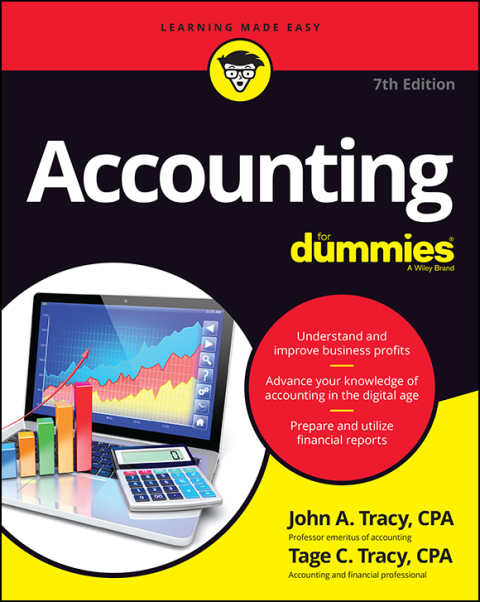Description
Efnisyfirlit
- Cover
- Title Page
- Copyright
- Introduction
- About This Book
- Foolish Assumptions
- Icons Used in This Book
- Beyond the Book
- Where to Go from Here
- Part 1: Opening the Books on Accounting
- Chapter 1: Accounting in Today’s New Economy
- Checking Your Preconceptions about Accounting
- Providing Vital Financial Information
- Accounting’s Two Primary Roles
- Taking a Peek behind the Scenes
- Focusing on Transactions
- Taking the Financial Pulse of a Business
- Accounting as a Form of Art
- Chapter 2: Introducing Financial Statements
- Setting the Stage for Financial Statements
- The Income Statement
- The Balance Sheet
- The Statement of Cash Flows
- A Note about the Statement of Changes in Shareowners’ Equity
- Gleaning Important Information from Financial Statements
- Complying with Accounting and Financial Reporting Standards
- Chapter 3: Safeguarding Company Assets
- Separating the Duties of Bookkeepers and Accountants
- Pedaling through the Bookkeeping Cycle
- Managing Accounting Systems
- Enforcing Strong Internal Controls
- Double-Entry Accounting
- Juggling the Books to Conceal Embezzlement and Fraud
- Chapter 4: Accounting in the Digital Age
- Noting a Few Foundational Accounting Concepts Related to Technology
- Using Accounting Software in the Cloud and on the Ground
- Controlling and Protecting Money Flows in the Electronic Age
- Managing the Accounting Function in the On-Demand World
- Chapter 5: Recognizing the Legal and Accounting Entity
- Being Aware of the Legal Roots of Business Entities
- Going It Alone: Sole Proprietorships
- Differentiating Partnerships and Limited Liability Companies
- Incorporating a Business
- Part 2: Exploring Financial Statements
- Chapter 6: Reporting Profit or Loss in the Income Statement
- Presenting Typical Income Statements
- Taking Care of Housekeeping Details
- Being an Active Reader
- Deconstructing Profit
- Pinpointing the Assets and Liabilities Used to Record Revenue and Expenses
- Reporting Unusual Gains and Losses
- Watching for Misconceptions and Misleading Reports
- Chapter 7: Reporting Financial Condition in the Balance Sheet
- Expanding the Accounting Equation
- Presenting a Proper Balance Sheet
- Judging Liquidity and Solvency
- Understanding That Transactions Drive the Balance Sheet
- Sizing Up Assets and Liabilities
- Financing a Business: Sources of Cash and Capital
- Recognizing the Hodgepodge of Values Reported in a Balance Sheet
- Chapter 8: Reporting Cash Sources and Uses in the Statement of Cash Flows
- Meeting the Statement of Cash Flows
- Explaining the Variance between Cash Flow and Net Income
- Sailing through the Rest of the Statement of Cash Flows
- Pinning Down “Free Cash Flow”
- Limitations of the Statement of Cash Flows
- Chapter 9: Financial Accounting Issues
- Reporting Changes in Owners’ Equity
- Recognizing Reasons for Accounting Differences
- Looking at a More Conservative Version of the Company’s Income Statement
- Explaining Differences
- Calculating Cost of Goods Sold Expense and Inventory Cost
- Recording Depreciation Expense
- Scanning the Revenue and Expense Radar Screen
- Using the Statement of Cash Flows as an Audit/Sanity Test
- Part 3: Understanding Financial Reports, Financial Statements, and Financial Information
- Chapter 10: Producing Financial Reports
- Quickly Reviewing the Theory of Financial Reporting
- Recognizing Top Management’s Role
- Keeping Current with Financial Accounting and Reporting Standards
- Making Sure Disclosure Is Adequate
- Putting a Spin on the Numbers (Short of Cooking the Books)
- Comparing Public and Private Companies
- Dealing with Information Overload
- Chapter 11: Deciphering a Financial Report
- Knowing the Rules of the Game
- Making Investment Choices
- Contrasting Reading Financial Reports of Private Versus Public Businesses
- Explaining the Role of MDORs and MD&As
- Frolicking through the Footnotes
- Checking Out the Auditor’s Report
- Chapter 12: Analyzing Financial Information with Ratios
- Understanding the Importance of Using Ratios to Digest Financial Statements
- Improving Your Knowledge of Financial Language and Lingo
- Starting with Sample Company Financial Statements
- Benchmark Financial Ratios: Financial Strength and Solvency
- Benchmark Financial Ratios: Financial Performance
- Making Time for Additional Ratios (If Needed)
- Chapter 13: Generating Internal Financial Information for Management Use
- Building on the Foundation of the External Financial Statements
- Distinguishing Internal and External Financial Statements
- Gathering Financial Condition Information
- Culling Profit Information
- Avoiding Rookie Mistakes
- Chapter 14: Applying Wall Street’s Tricks and Treats to Engineer Financial Results
- Knowing What Financial Engineering Is Not
- Defining What Financial Engineering Is
- Identifying Commonly Used “Tricks of the Trade”
- Manufacturing Imaginary Profits (and, Yes, Losses)
- Looking Out for Particular Trends and Terminology
- Part 4: Leveraging Accounting in Managing a Business
- Chapter 15: Analyzing Profit
- Helping Managers: The Fourth Pillar of Accounting
- Internal Profit Reporting
- Looking at Strategic Profit Analysis
- Taking a Closer Look at the Lines in the Profit Template
- Using the Profit Template for Decision-Making Analysis
- Tucking Away Some Valuable Lessons
- Chapter 16: Accounting for Costs
- Looking Down the Road to the Destination of Costs
- Are Costs Really That Important?
- Becoming More Familiar with Costs
- Assembling the Product Cost of Manufacturers
- Puffing Profit by Excessive Production
- Chapter 17: Preparing Best-in-Class Forecasts, Projections, and Budgets
- Focusing on Key Forecasting Concepts
- Putting Forecasting in Its Place
- Exploring Forecasting
- Increasing the Power of Your Forecasts
- Seeing a Financial Forecast in Action
- Rehashing the Value of Forecasts
- Chapter 18: Capitalizing a Business: How, When, Why, and What
- Identifying the Elements of a Business Plan
- Valuing Businesses: A Crash Course in the Basics
- Surveying Commonly Used Business Valuation Techniques
- Summarizing the Two Basic Types of Available Capital
- Taking a Deeper Dive into Raising Debt Capital
- Digging Further into the World of Equity Capital
- Raising Capital: Tips, Tidbits, and Traps
- Part 5: The Part of Tens
- Chapter 19: Ten Tips for Managers
- Reach Breakeven and Then Rake in Profit
- Set Sales Prices Right
- Don’t Confuse Profit and Cash Flow
- Call the Shots on Accounting Policies
- Prepare Accurate Forecasts and Projections
- Demand the Accounting Information You Want
- Tap into Your CPA’s Expertise
- Critically Review Your Controls over Employee Dishonesty and Fraud
- Lend a Hand in Preparing Your Financial Reports
- Speak about Your Financial Statements as a Pro
- Chapter 20: Ten Tips for Reading a Financial Report
- Get in the Right Frame of Mind
- Decide What to Read
- Improve Your Accounting Savvy
- Judge Profit Performance
- Test Earnings Per Share (EPS) against Change in Bottom Line
- Tackle Unusual Gains and Losses
- Check Cash Flow from Profit
- Look for Signs of Financial Distress
- Recognize the Possibility of Restatement and Fraud
- Remember the Limits of Financial Reports
- Index
- About the Authors
- Connect with Dummies
- End User License Agreement





